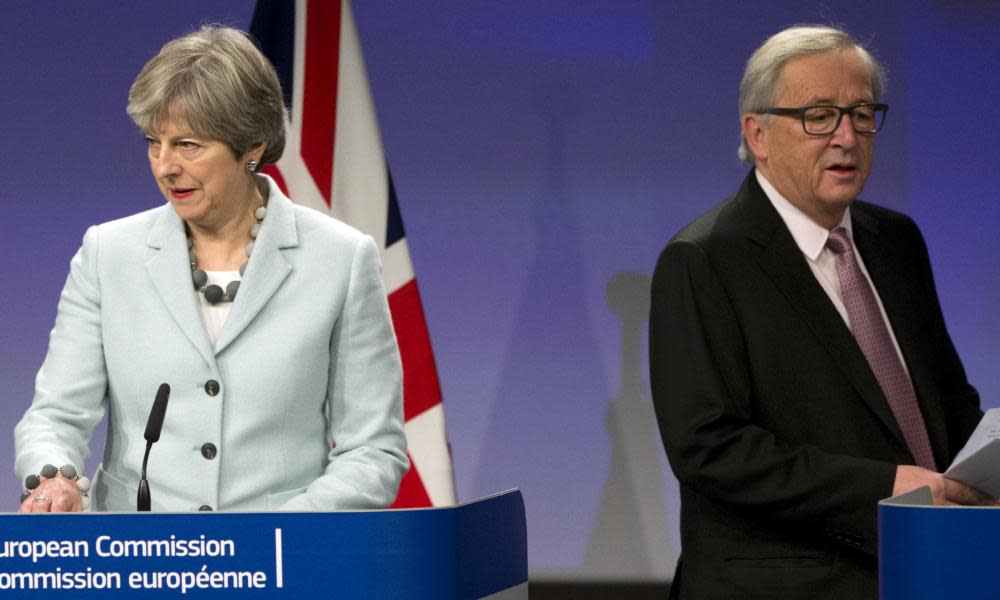Not much remains of Theresa May's red lines after the Brexit deal | Dan Roberts

If the EU referendum was the moment the British electorate clashed with the establishment, 8 December 2017 was the day that the legal and economic consequences collided with its political promises. The joint divorce agreement hammered out in the intervening 528 days makes clear that little remains of the many red lines set out by Theresa May in her Lancaster House speech or party conference address of 2016.
The first, and biggest, concession is buried in paragraph 49 of the 15-page report published early on Friday morning. Its implications will be anything but quiet in the weeks to come, for it undermines the prime minister’s previous insistence that Britain will be leaving the single market.
It states clearly: “In the absence of agreed solutions, the United Kingdom will maintain full alignment with those rules of the internal market and the customs union.” In other words, the UK may not be a member of the single market, or have any direct ability to shape its rules in future, but it could yet have to play by them in perpetuity.
Much will be made of the “in the absence of agreed solutions” caveat, yet what it means in practice is that the UK hopes to flesh out this pledge through a wider free trade agreement with the EU. If the other 27 members were reluctant to allow any wriggle room in the first phase of talks, they are even less likely to budge now that this principle is established as a back-stop.
When the agreement was first drafted on Monday, there was much concern that the promise of maintaining regulatory “alignment” might only apply to Northern Ireland, but the Democratic Unionist party has succeeded in removing any ambiguity and forced Downing Street to spell out that alignment stretches right across the Irish sea.
“The United Kingdom will ensure that no new regulatory barriers develop between Northern Ireland and the rest of the United Kingdom,” says the text now – unless, by some miracle, the Northern Ireland assembly were to decide it did, after all, want to be cut off.
Then there is the UK’s promise to free itself from interference by the European court of justice. Where once this seemed the most implacable of red lines, signs of continued ECJ involvement are strewn throughout the divorce agreement.
Most striking is the commitment to allow EU citizens living in UK to continue to rely on the court to enforce the many legal rights that will be enshrined as a result of the agreement.
“For EU citizens the ECJ will still be competent,” said Jean-Claude Juncker, as he announced the deal.
The agreed text goes further, saying it “establishes rights for citizens following on from those established in union law during the UK’s membership of the European Union”. Specifically, it says “the [ECJ] is the ultimate arbiter of the interpretation of union law” and “UK courts shall therefore have due regard to relevant decisions of the [ECJ] after the specified date [of departure]” as well as consulting with it if the law is unclear.
In the last few days, as compromise became inevitable, the British government had attempted to limit this ongoing role to less than five years. The final text includes a sunset clause of eight years instead.
But this may just be the start of the ongoing legal alignment. A separate statement by the EU council president, Donald Tusk, on the principles of the next stage of negotiations, makes clear that the UK will be fully required to abide by ECJ rulings during the two-year transition phase after departure. “I propose that during this period, the UK will respect the whole of EU law, including new law … [and] it will respect judicial oversight,” said Tusk.
Another clause allowing the UK to continue to participate in EU programmes and agencies hints that the ECJ may be a feature of British life long after the eight-year sunset clause and the two-year transition phase too: “Participation in union programmes will require the UK to respect all relevant union legal provision.”
Finally there is the question of money. May had promised an end to large ongoing payments to the EU. Boris Johnson said it could “go whistle” if it wanted an exorbitant divorce settlement.
Though the text includes no figures, detailed commitments by the UK to meet all the initial financial requests of the EU suggest both these promises may look increasingly hollow, with a total bill of perhaps up to €60bn or more than £50bn.
In her Florence speech, May first conceded that the UK would honour all the ongoing spending commitments of the current EU budget round, even after Brexit. But the divorce agreement makes clear this extends to future spending many years beyond that too. These so-called reste à liquider (RAL) payments will be made when they fall due, rather than upfront, but this only lengthens the extent of British financial obligations.
The UK has also agreed that various contingent liabilities, such as foreign loans and staff pensions, will similarly be offset by some assets it has identified in the EU books. But this means it will take more than a decade, for example, for the UK to be reimbursed for the money it has paid into the European Investment Bank.
The €300m annual payments may prove scant compensation for the billions flowing the other way in financial settlements or the lasting regulatory and legal concessions that the UK has had to pay as the price of merely getting to talk about a future trade deal.

 Yahoo News
Yahoo News 
